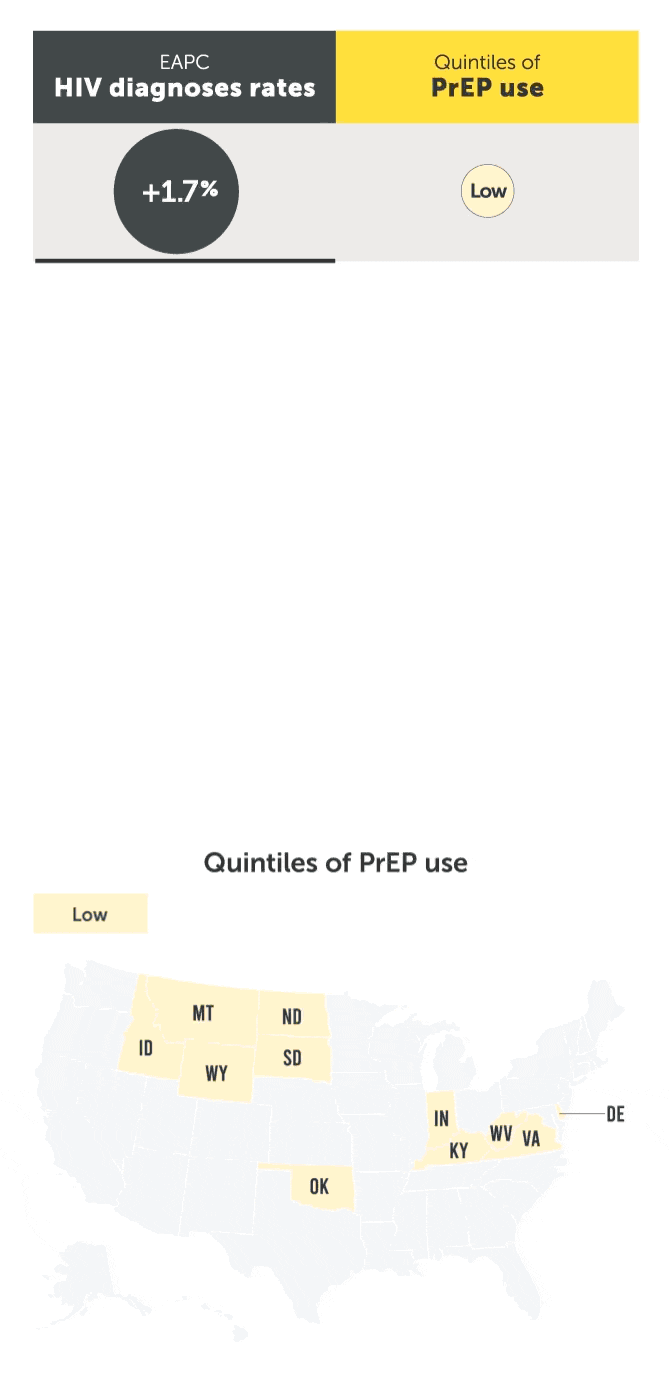PrEP medications have been an established HIV prevention strategy for over 10 years1
Effectiveness of HIV prevention strategies
PrEP is


effective at reducing HIV among men who have sex with men3*
effective at reducing HIV among heterosexual couples3*
Inconsistent condom use is less effective.3
CDC guidelines state individuals should be reminded that PrEP medications do not protect against other STIs, and condoms should be considered part of a comprehensive safer sex practice.2,4
*CDC has stated that condom efficacy may be higher when used correctly.5
STI=sexually transmitted infection.
PrEP has made a significant impact in helping reduce new HIV diagnoses6
Areas with higher levels of PrEP usage saw larger declines in HIV diagnoses6
Estimated annual percent change (EAPC) in HIV diagnoses rates (%) per state quintiles of PrEP usage6†

† The publicly available data on PrEP prescriptions and CDC estimates of people with PrEP indications were used to determine mean PrEP coverage (calculated as number of PrEP users/100 persons with indications) from 2012 to 2021 by quintiles for 50 US states and the District of Columbia. For each PrEP quintile, EAPC in HIV diagnosis rates from 2012 to 2021 was calculated with a CI of 95% using temporal trends models and a p value for trend across state-specific quintiles of coverage. EAPC estimates were adjusted for prior state-level viral suppression to account for higher PrEP coverage in states confounded by higher levels of viral suppression.6

(Tao L, 2023; 522,273 prescriptions of PrEP were analyzed between January 2019 and February 2023, selected from IQVIA® LAAD. Observational study compared delays of PrEP dispensation from day 0, when PrEP was dispensed.7)
IQVIA LAAD=IMS Health, Quintiles, and VIA Longitudinal Access and Adjudication Data.

References:
1. Centers for Disease Control and Prevention. US Public Health Service: Preexposure prophylaxis for the prevention of HIV infection in the United States—2021 Update: a clinical practice guideline. Accessed September 12, 2024. https://www.cdc.gov/hiv/pdf/risk/prep/cdc-hiv-prep-guidelines-2021.pdf
2. Centers for Disease Control and Prevention. HIV Nexus: CDC resources for clinicians. Updated August 20, 2024. Accessed September 4, 2024. https://www.cdc.gov/hivnexus/hcp/prep/index.html
3. Smith DK, Herbst JH, Zhang X, Rose CE. Condom effectiveness for HIV prevention by consistency of use among men who have sex with men in the United States. J Acquir Immune Defic Syndr. 2015;68(3):337-344.
4. Centers for Disease Control and Prevention. Pre-exposure prophylaxis (PrEP). Updated July 5, 2022. Accessed October 22, 2024. https://www.cdc.gov/hiv/risk/prep/index.html
5. US Preventive Services Task Force; Owens DK, Davidson KW, Krist AH, et al. Preexposure prophylaxis for the prevention of HIV infection: US Preventive Services Task Force recommendation statement. JAMA. 2019;321(22):2203-2213.
6. Sullivan PS, Dubose S, Brisco K, Gordon L, Juhasz M. Association of state-level PrEP coverage and state-level HIV diagnosis, US, 2012-2021. Abstract presented at: Conference on Retroviruses and Opportunistic Infections (CROI); March 3-6, 2024; Denver, CO.
7. Tao L, Yang J, Zachry W, Gruber J, Mezzio D. The real-world impact of pre-exposure prophylaxis (PrEP) prescription uptake and dispensing status on HIV infection risk in the US. Poster presented at: IDWeek 2023; October 11-15, 2023; Boston, MA. Poster 1557.
